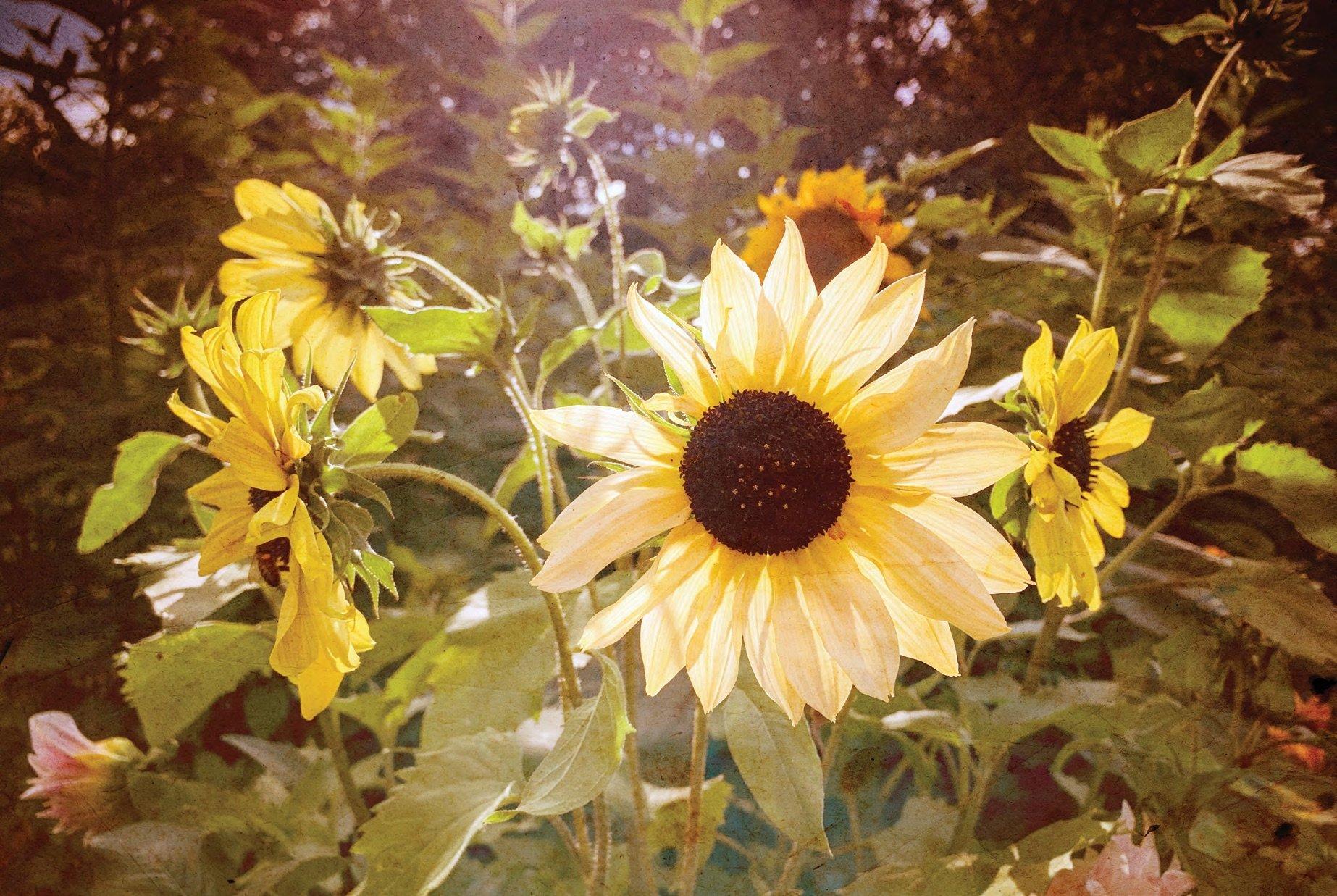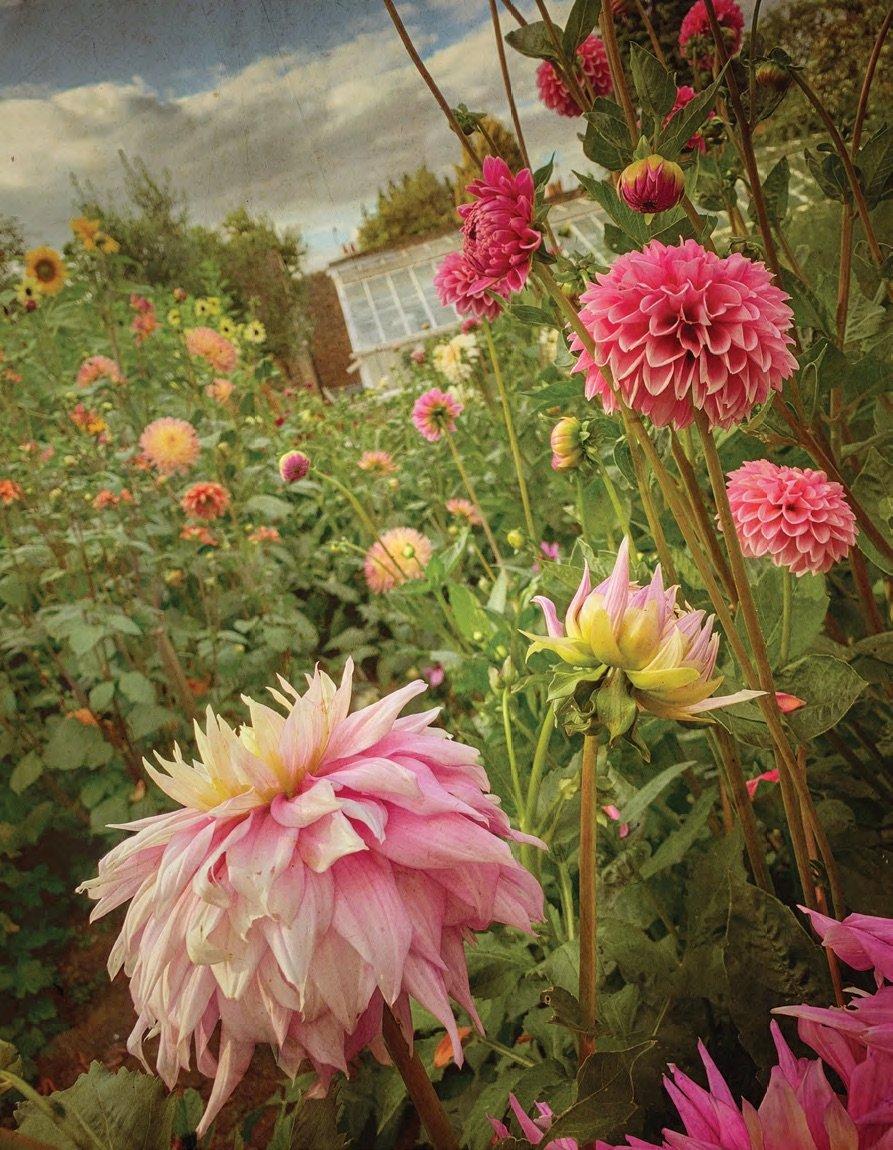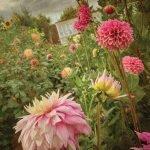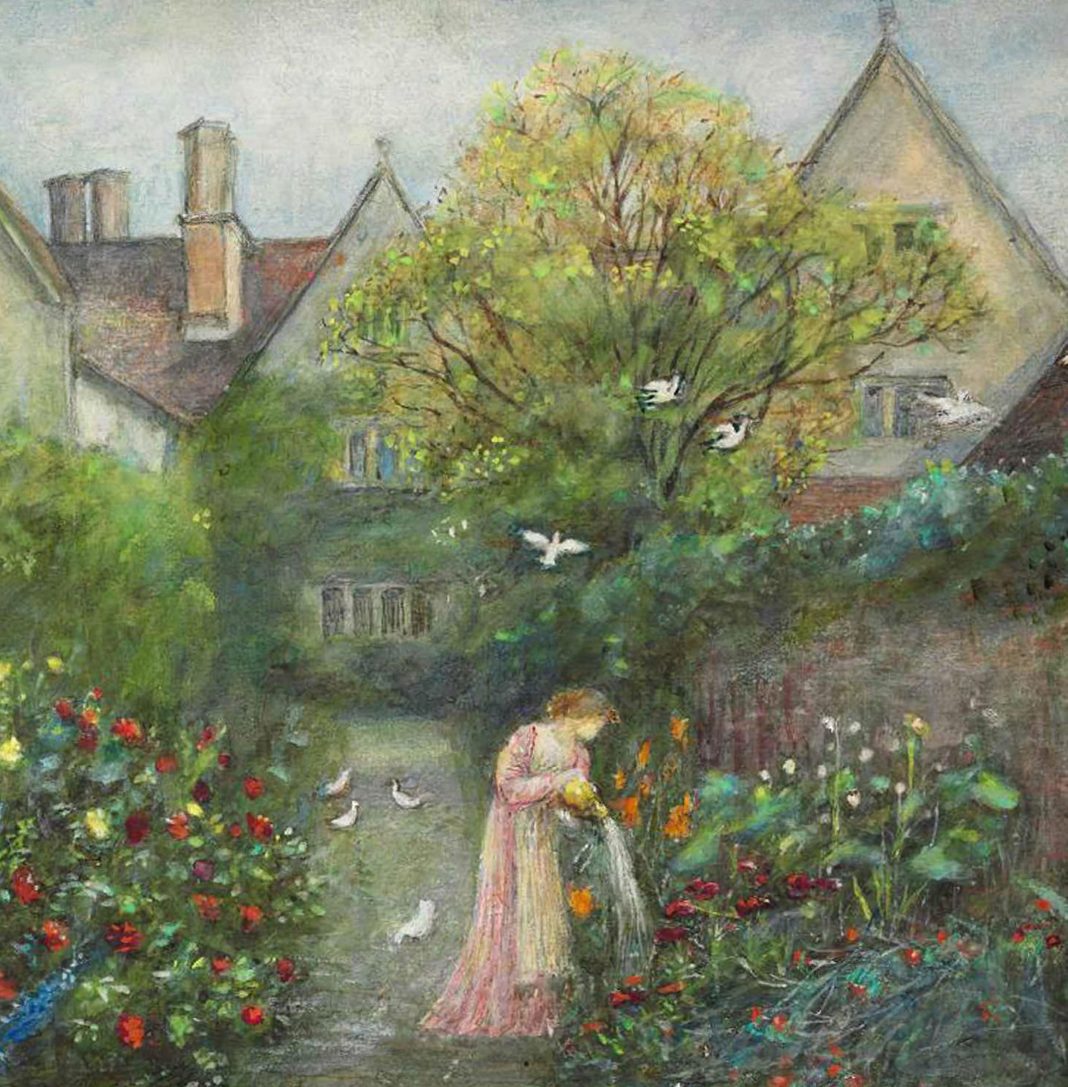Photography by Tea & Morphine
“My mom sent this,” my friend Jessica says, eyes gleaming. “I think I kept it alive.” In her hands is a garden pot with a fledgling rose bush, red tinging its winter leaves. It’s a Tuscany rose, a species dating to the late Middle Ages, that’s come from Karen, her mother, who is the closest thing you’ll ever find to a real medieval lady of the manor. It’s come from the garden on her South Georgia horse farm to Middle Tennessee, and I will baby it through the winter. In spring, I reciprocate by taking her one of my Pompom de Bourgogne, a tiny deep pink rose dating to at least 1660. These old garden roses send up suckers regularly, making propagation for those of us who long for medieval gardens a marvelous possibility.
Loving medieval gardens isn’t a new thing. The Pre-Raphaelites included a garden obsession in their own vision of medievalism. You’ll see it reflected in their art. The language of flowers is prominent in the work of Rossetti, Millais, Burne-Jones, and Waterhouse. Indeed, nature and the outdoors are so much a part of the Pre-Raphaelite oeuvre that they appear in the tapestry work and interior design of William Morris and Co. and the Edinburgh school, for example. Morris has always been my personal touchstone for both gardens and décor, and I share the passion he had for all of it, I hope.
Reading medieval literature, I always longed for a medieval garden of the sort where clever, beautiful humans and mythic animals could adventure through deep-scented foliage. I suspect Morris felt the same way as he, Janey, and his artist friends planned Red House. (Read more about Red House here.) Then, quite by accident, one day I made my own, just as Morris did.
We settled in on Christmas Eve. On Christmas Day, in biting cold, I began to dig up the awful front garden bed, putting out my transferred treasures in front of the Craftsman-style home: sprouting daffodil bulbs from a 150-year-old farm, wild double tiger lilies, and sage and rosemary bushes imported in tubs. (I also dragged along stray violets.) I left huge planters of herbs by the concrete back porch and hoarded my paper bags of saved seeds: marigolds, cosmos, zinnias, basil, bachelor’s buttons.
Eight years ago, I married and moved to a tiny ranch-style farmhouse in the suburban country outside Nashville. The property was rather a mess, but it had land and a barn where Seth, my husband, could practice his metalsmithing hobby. We stayed for five years, barely fitting. There I discovered I had a “thing” for gardening. The hedge witch in me flourished. The semi-wild environment worked with my attempts at cultivation; I blended local flora with things I imported from home stores and farmers’ markets. I rambled in the adjoining fairy woods. Then we passed on purchasing the property and bought a bigger house in the suburbs. Everything changed.
Everything survived the ice. I spoke to my friend Charlotte (of Nightshade Handmade), whom I’d met through an herbal guild in our medieval re-enactment group. I layered mulch on the weak garden bed to limit the Bermuda grass. I relegated bland, sad nandina to the compost. By spring, I’d ordered roses and currant bushes, planted my treasured seeds, and started extending the garden.

Charlotte brought me a beautiful little rosebush and sweet viola odorota. Other friends brought offerings—tiny pink daylilies, a potted rose of Sharon, irises. My parents bought the yard’s second tree, a Japanese maple to go with the holly. Seth helped me edge with local rocks and didn’t grumble when I built the first back garden using cardboard layered under mulch. Then came side gardens, slowly and slyly, rich with new hellebores, foxgloves, lupines, peonies, hollyhocks, and dahlias, then gooseberries, strawberries, flame-orange cherry tomatoes, Chesapeake fish peppers, buttery lettuces, lavender, and five kinds of thyme. Dye plants, hibiscus, heirloom geraniums, eight more roses, blueberries, and herbs by the potful.
My lovely neighbors to the east admired my roguish efforts. There was no suburbia as I went wild, adding more color, with little thought of the careful organization. (I’d eventually have to justify this to the homeowners association, but it turns out that my lovely neighbors are on it.)
I saved all my seeds, passing on bags of mixed full gardens to friends and family across the country—a little of my own personal magic, as close to love as you can put in a small cotton bag.
At Halloween this year, as teeny witchies and monsters roamed my neighborhood, I heard someone say through my window, “I love this house, it’s like a Utopia for flowers.”
In winter, as dead annuals still stand, my front yard is cat TV, a haven for songbirds braving the cold to eat zinnia seeds, and the neighbor’s cat, taunting my leash-only trio through the window, rolling in the catnip and lemon balm. In the other seasons, it’s a safe space for pollinators, moths, butterflies, and visiting wildlife, tangled enchantment.
And somehow, I found myself caught up reading a book on Brother Cadfael’s gardens in the popular novels and TV series and heard an unfamiliar term: potager urbain. And I realized exactly what spells I’d been casting all along.
Properly, the French potager urbain, like the English cottage garden, descends from ancient world and medieval counterparts. It’s a garden of useful plants: a riotous mixture of fruits, vegetables, herbs, flowers, plants for dyeing and cloth production, medicines, and pest repelling.
Such gardens derived from the villa gardens of the Roman Empire, which inspired monastery gardens under Benedictine Rule and the gardens of medieval and Renaissance households in cities and towns across Europe. I dug in, reading about the previously unimagined gardens of medieval cities, with each householder keeping their own allotment.
As I write, I’m literally digging in for spring. Intuitively, I’d already added plenty of medieval and heirloom species. But with the true urban household garden, placement is personal and fearless: garlic with verbena and marigolds, lettuces with saffron crocuses, figs with carrots and nasturtiums.
I learned location tactics based on what space I had, discovering that mixing varieties together provides a plethora of benefits, from rebuilding soil nutrients naturally to repelling pests.
Suburban gardens lost their magic long ago. They’ve become an exercise in dullness: the same plants, given little care, only there for show. But it is entirely possible to build a garden that is beautiful and useful. Walk out your front door to cut lettuce for a salad, thyme and sage for the chicken, and flowers to decorate the table—much like Morris, Brother Cadfael, and every garden witch in every novel ever written has done. A little effort in watering, mulching, and weeding is all you need. Incredible results come from thinking like a Pre-Raphaelite gardener with a medieval eye.

SOURCES FOR VICTORIAN, MEDIEVAL AND FANCIFUL PLANTS:
High Country Roses – Modern and historic rose species, highly recommended. highcountryroses.com
Baker’s Creek Heirloom Seeds – Older species and rare vegetables, fruits, herbs, and flowers. rareseeds.com
White Flower Farm – On the pricier side, gorgeous floral options, and also some domestic accessories like wreaths. Fantastic spring bulbs. whiteflowerfarm.com
Stark Brothers – Fruit trees and bushes, gardening supplies. I got currants and gooseberries here. starkbros.com
Pine Knot Farms – Hellebores galore. pineknotfarms.com
Burpee Seeds – Forget the ones you buy at big box stores. Ordering directly will make you happier. Wide selection, good prices, better coupons. Vegetables, fruits, flowers, herbs, you name it. burpee.com
Select Seeds – Older and heirloom varieties. I got medieval rose geranium and Victorian species here. selectseeds.com
How do you tell your varieties are truly the medieval ones? A good place to start is with this book: Sweet Herbs and Sundry Flowers: Medieval Gardens and the Gardens of the Cloisters by Tania Bayard. It’s out of print, but you can find cheap used copies on Amazon.
MORE WORTHWHILE READING:
William Morris: Artist, Craftsman, Pioneer, R. Ormiston and N.M. Wells
Brother Cadfael’s Herb Garden: An Illustrated Companion to Medieval Plants and Their Uses, Robin Whiteman
The Medieval Flower Book, Celia Fisher
Gardens of Pompeii, Annamaria Ciarallo
Botanical Shakespeare: An Illustrated Compendium of All the Flowers, Fruits, Herbs, Trees, Seeds, and Grasses Cited by the World’s Greatest Playwright, Gerit Quealy
Culpeper’s Complete Herbal: Over 400 Herbs and Their Uses, Nicholas Culpeper
Medieval English Gardens, Teresa McLean The Pre-Raphaelite Language of Flowers, Debra N. Mancoff



































